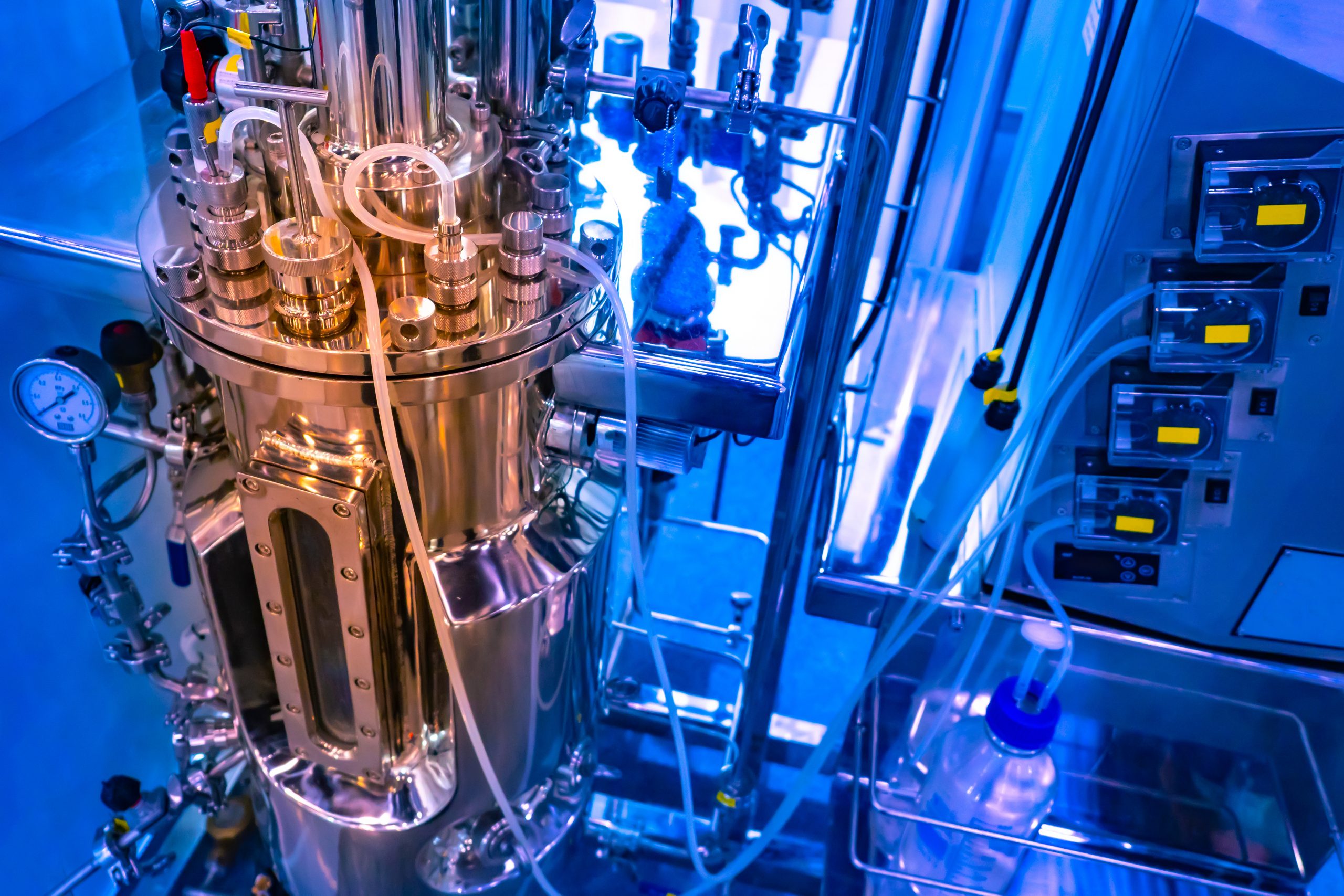
What could be the role of fermentation in the alternative protein field? This article highlights some advantages of biomanufactured proteins over plant-based proteins and some remaining challenges to address.
Advantages
Fermentation based processes present several advantages over animal and plant-based proteins:
- Space and mass efficiency. Fermentation allows to produce much more protein per surface area unit than pulses and does not require the use of new arable lands if you need to increase the production. In addition, pulses will generate waste (leaves, stems, roots) whereas fermentation uses everything.
- Reliability. Unlike crops, fermentation is not weather-dependent and allows non-stop production beyond the growing season.
- Environmental friendliness. Fermentation uses less water than crops, requires less land,…In addition, some companies are looking at using C1 as a feedstock for fermentation. We can cite for example String Bio which relies on methane or Air Protein which produces alternative meat and seafood from carbon dioxide gas.
- Organoleptic properties. One major drawback of plant-based proteins is their bitterness linked to plants’ defense mechanisms. Traditional fermentation like the fungi-based bitter blocker ingredient and protein from MycoTechnology can help to remove bitterness from plant proteins.
- Nutrition properties. Many plant-based proteins lack one or more amino acids as well as vitamins. For example, pea and soybean proteins are low in cysteine and methionine. Plant-based proteins also have antinutritional factors such as phytic acid or lectins that can interfere with the absorption of nutrients and lowering their bioavailability. Precision fermentation can help to enrich biomass in a target molecule (protein, fat, or any molecule or compound that is producible through a biological pathway, such as pigment, a vitamin, a flavor, or an aroma). Traditional fermentation like tempeh can also help to break down antinutritional factors and increase the bioavailability of minerals such as zinc or iron.
- Functionalization. Typically, the production of plant-based proteins requires functionalization after protein isolation while precision fermentation allows tailoring the protein with the functionality of interest.
- Price: Fermentation has the potential to achieve a competitive price. Traditional and biomass fermentation have established examples for economic viability and industrial scale and precision fermentation is promising even though it will require additional scaling and cost reduction. For example, food enzyme prices range from USD 1/kg to USD 100/kg for relatively pure proteins and the price of lysine amino acid produced by fermentation at large volumes ranges from USD 1.5 to 3 per kg with a high degree of purity. These examples can serve as benchmarks for achievable prices for alternative proteins from fermentation. For comparison, whey protein isolate, typically costs around USD 7.5/kg,100%protein, soy protein isolate costs USD 2/kg,100%protein and pea proteins costs USD 5/kg, 100%protein.
Challenges
For 2021, Merck’s Future Insight Prize (EUR 1,000,000 incentive) is focused on Food Generation to fund the development of a dream product converting any non-edible biomass into readily edible fully nutritional food within one day without any biohazard.
Indeed, scaling up fermentation is still facing some challenges:
- Productivity: Fermentation relies on 40 years of experience to produce enzymes. However, enzymes are used at a much lower rate than alternative proteins would be to have a significant impact on food security and sustainability.
- Feedstock: Sustainability must include the entire ecosystem from clean energy sources to feedstock. Feedstocks are the major cost driver for most fermentation processes. Feedstock optimization is key to ensure economic viability and sustainability. Industrial-scale production of protein from fermentation requires a lot of sugar that is still coming from traditional agriculture. The use of alternative feedstock such as side-streams, waste streams, or even C1 (CO2 or methane) is an important pathway investigated by start-ups like AirProtein and Solar Foods or the DECAF project from CPI. The use of C1 supports greenhouse emissions reduction.
- Human resources. Fermentation and biotechnologies require skilled and expensive labor that can be very long to build from scratch with most resources working for the pharma and the chemicals industry which require different skillsets than food.
- Scale-up. Dealing with living organisms makes fermentation challenging to scale up with issues that are not visible at a small scale. Very large scale systems tend to be highly heterogeneous with several gradients (oxygen, food, shear,…) and, thus, require robust and tolerating cells.
- Process time. Lowering prices require to decrease the time of processing and thus to move from standard batch fermentation to continuous fermentation which can generate technical problems such as contamination, cell instability…
- Partnerships. These types of challenges require partnerships among players that are not necessarily used to collaborate together (biotech partners, production partners, downstream partners…). Last year has witnessed a series of alliances such as The PLANeT Partnership (the joint venture of Beyond Meat and Pepsi to make plant-based snacks and drinks), Novozyme has created its spin-off NovoProteins to facilitate collaborations… Partnerships of start-ups with existing companies that have infrastructures that can be leveraged cost-effectively allow them to move much quicker. The partnership between the start-up Perfect Day and ADM will allow the startup to use ADM’s fermentation infrastructure to reduce the cost of making its animal-free whey protein. Another example is the repurposing of ethanol plants for the mass production of alternative proteins such as the Central Minnesota Renewables (CMR) ethanol plant in Little Falls, Minnesota purchased by White Dog Labs. Indeed, retrofeeding a plant can take 3 to 6 months whereas building new sites from scratch can take 1 to 2 years. In addition, acceptance from the consumer will likely require a joint effort from the entire industry and not just one company.
- Regulation and consumers perception. Perfect Day has received approval for its whey protein from the FDA that was recognized as safe in 2020. According to Perfect Day, the key is to start with a host already recognized as safe and a protein already consumed and provide inputs about potential impurities and allergens. Consumers have been using enzymes in cheese and fermented products for a long time so consumers’ acceptance should be good. The lack of common term for the fermentation-based ingredients could lead to consumers’ confusion even though the history of fermented products and the recent research on the health benefits of fermented foods is likely to help.
Sources:
- https://www.aocs.org/stay-informed/inform-magazine/featured-articles/fermentation-the-new-protein-supply-chain-april-2019?SSO=True>
- Ikeda M. Lysine Fermentation: History and Genome Breeding. Advances in Biochemical Engineering/biotechnology. 2017;159:73-102. DOI: 10.1007/10_2016_27.
- Razak, M.A., Viswanath, B. Optimization of fermentation upstream parameters and immobilization of Corynebacterium glutamicum MH 20-22 B cells to enhance the production of l-lysine. 3 Biotech 5, 531–540 (2015). https://doi.org/10.1007/s13205-014-0252-7
- Mackinsey & company Agriculture Practice Alternative proteins: The race for market share is on
- https://www.biofuelsdigest.com/bdigest/2020/05/03/from-food-to-fuel-white-dog-labs-converts-ethanol-plant-to-alternative-protein-production/






